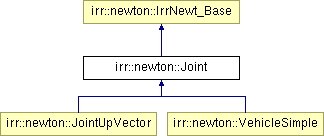
#include <joint.hpp>
Inheritance diagram for irr::newton::Joint:

Public Member Functions | |
| bool | getCollisionState () |
| const NewtonJoint * | getNewtonJoint () const |
| irr::f32 | getStiffness () |
| Joint () | |
| void | setCollisionState (bool value) |
| void | setStiffness (irr::f32 value) |
| ~Joint () | |
Protected Attributes | |
| NewtonJoint * | n_joint |
| NewtonWorld * | n_world |
| irr::newton::Joint::Joint | ( | ) | [inline] |
constructor. don't call this directly
| irr::newton::Joint::~Joint | ( | ) | [inline] |
destructor
| bool irr::newton::Joint::getCollisionState | ( | ) |
Get the collision state of the two bodies linked by the joint
usually when two bodies are linked by a joint, the application wants collision between this two bodies to be disabled. This is the default behavior of joints when they are created, however when this behavior is not desired the application can change it by setting collision on. If the application decides to enable collision between jointed bodies, the application should make sure the collision geometry do not collide in the work space of the joint.
| const NewtonJoint* irr::newton::Joint::getNewtonJoint | ( | ) | const [inline] |
get newton joint
| irr::f32 irr::newton::Joint::getStiffness | ( | ) |
Get the strength coefficient bing applied to the joint reaction forces See Joint::setStiffness()
| void irr::newton::Joint::setCollisionState | ( | bool | value | ) |
Enable or disable collision between the two bodies linked by this joint. The default state is collision disable when the joint is created.
| value | true to enable collision between linked bodies, false to not |
| void irr::newton::Joint::setStiffness | ( | irr::f32 | value | ) |
Set the strength coeficient to be applied to the joint reaction forces
Constraint keep bodies together by calculating the exact force necessary to cancel the relative acceleration between one or more common points fixed in the two bodies. The problem is that when the bodies drift apart due to numerical integration inaccuracies, the reaction force work to pull eliminated the error but at the expense of adding extra energy to the system, does violating the rule that constraint forces must be work less. This is a inevitable situation and the only think we can do is to minimize the effect of the extra energy by dampening the force by some amount. In essence the stiffness coefficient tell Newton calculate the precise reaction force by only apply a fraction of it to the joint point. And value of 1.0 will apply the exact force, and a value of zero will apply only 10 percent.
The stiffness is set to a all around value that work well for most situation, however the application can play with these parameter to make finals adjustment. A high value will make the joint stronger but more prompt to vibration of instability; a low value will make the joint more stable but weaker.
| value | stiffness coeficient, a value between 0, and 1.0, the default value for most joint is 0.9 |
NewtonJoint* irr::newton::Joint::n_joint [protected] |
the newton joint
NewtonWorld* irr::newton::Joint::n_world [protected] |
the newton world
 1.5.1-p1
1.5.1-p1